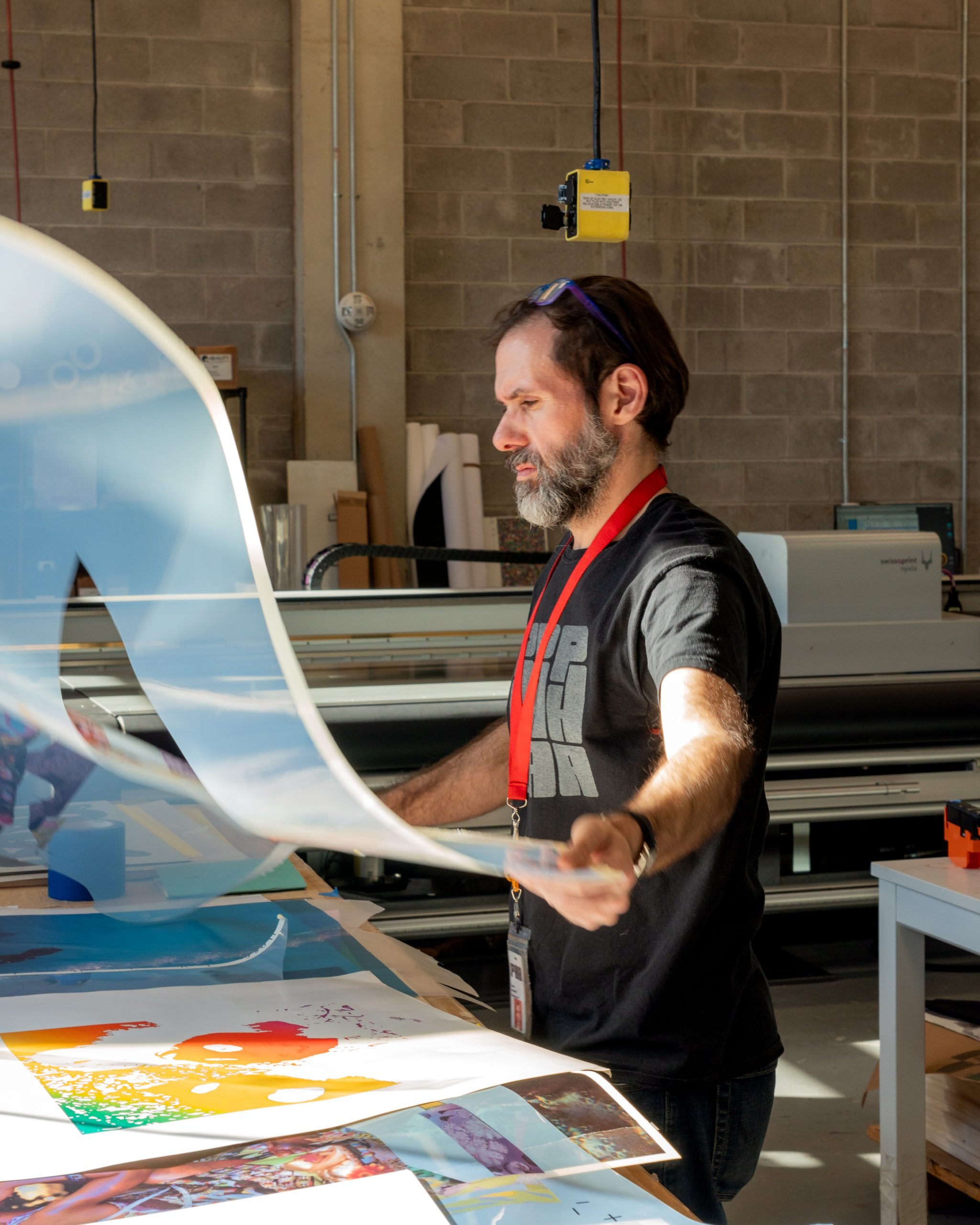
Housed in a 117-year-old former power plant in the Gowanus neighborhood of Brooklyn, New York, Powerhouse Arts opened its doors in May 2023 to artists, designers, and other creatives. The site gives participants expansive access to fabrication facilities, a variety of workshops, performance and exhibitions spaces, and as a site for experimentation and collaboration. The brainchild of philanthropist Joshua Rechnitz, the burgeoning arts hub has recently evolved even further with a newly expanded Digital Print Lab.
The lab can accommodate both traditional and experimental printing projects—including creating works at monumental scales or printing on supports beyond just paper, such as canvas, wood, metal, and most plastics. But what perhaps sets the lab apart most is the in-house team of craftspeople and artisans who have more than centuries worth of combined experience with screen printing and other printmaking techniques.
Heralding this new expansion, we reached out to Powerhouse Arts Master Printmaker Dennis Hrehowsik to learn more about what the Digital Print Lab now has to offer, and what some of the recent projects artists have brought to life in the lab have been.
Dennis Hrehowsik. Courtesy of Powerhouse Arts, Brooklyn.
Tell us about your background and expertise, how long have you been working with Powerhouse Arts?
I’ve been working as a master screen printer for the last 22 years with our Print Director Luther Davis and have been with Powerhouse Arts since 2016. In fall of 2022, I accepted the challenge of developing our grand format digital print program and was named associate director of the Digital Print Lab this spring.
Powerhouse Arts recently expanded its Digital Print Lab; can you tell us a bit about the lab’s capabilities and what it can do?
The program began with the donation of an enormous, grand-format HP 3600 latex roll-to-roll printer from our partners at Flavor Paper. It can produce an image 126 inches wide by almost infinite length on any pliant material. We recently acquired a Swiss Q Nyala 1 flatbed U.V. printer that can print on rigid substrates such as wood, metal, and glass up to 126 inches by 63 inches at a thickness of almost two inches. It can also create white primed surfaces as well as clear varnishes in finishes from matte to high gloss. Both technologies can print on paper and gessoed artist canvas. Having both of these machines in our shop allows us to tackle an extremely wide variety of projects across sizes, materials, and mediums.
Rob Pruitt, an edition of Hoarfrost Pandas (A-H) (2024). Courtesy of the artist and Powerhouse Arts, Brooklyn.
How does the print lab fit within the greater creative ecosystem of Powerhouse Arts? What are some of the other available elements (e.g., fabrication capabilities)?
The multidisciplinary, cross-departmental opportunities that arise from our facility’s different services, along with a willingness to experiment, is a large part of what makes Powerhouse Arts so special. Yes, these printers can and do produce standalone works, but they are very often complemented with other services—like CNC milling in our Public Art department, or hand printing in our screen-printing shop to enhance the work with colors that are outside of the CMYK gambit.
Vittorio Corsini, Lo sguardo di Peccioli (Peccioli’s Gaze) (2017). Photo: Andrea Testi. © Fondazione Peccioliper Photographic Archive.
Can you tell us about a couple of recent projects that have been undertaken in the print lab?
There have been so many, but a few come to mind that showcase the different types of media we can accommodate. First, we recently completed a suite of prints with Rob Pruitt, released by Phillips Editions, that took advantage of the white primer on the Swiss Q to produce a full-fidelity color print on handmade silver washi paper. The results were spectacular. Second, a latex project for Jessica Vaughn that was featured at Frieze New York utilized the ability of the HP to turn any fabric into a digital media, so Jessica was able to incorporate an array of natural fabrics that may have not been possible elsewhere. Lastly, through a collaboration with our friends at Workspace11, located here in the Powerhouse Arts building, we did a piece with the artist Vittorio Corsini that utilized our ability to print on metal, which was a part of an outdoor sculpture that was installed at the Italian Cultural Institute.
Installation view of Jessica Vaughn, The Internet of Things (2020–2023), Frieze New York. Photo: Da Ping Luo. Courtesy of Frieze/The Shed.
What does the process of working with Powerhouse Arts look like, do artists come with fully formed ideas, or is there more of an element of experimentation?
This is why I love working here—projects can start with anything from a sketch on a cocktail napkin to fully designed installations or anything in between. We see ourselves as more than a printshop—we’re a full-service atelier where we help bring artists’ ideas into reality. We’re the team that prides itself on problem solving the jobs that everyone else said no to.
Learn more about printing at Powerhouse Arts, Brooklyn, here.